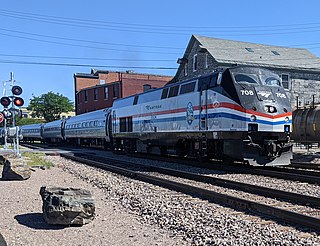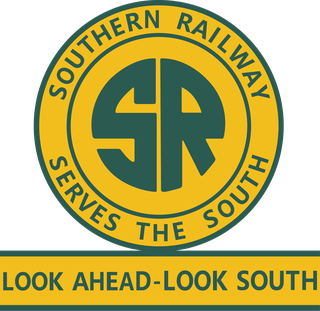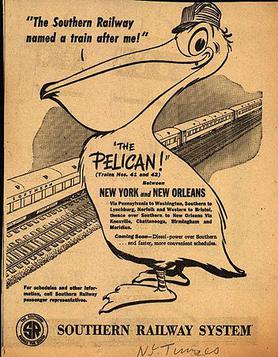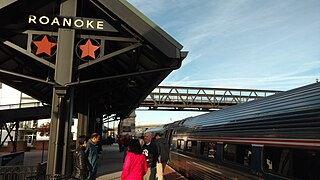
The Ethan Allen Express is a daily passenger train operated by Amtrak in the United States between New York City and Burlington, Vermont, via Albany, New York. One daily round trip is operated on a 310-mile (500 km) north–south route with a 7-hour 35 minute scheduled running time. The train is subsidized by New York and Vermont for the portion north of Albany. It is named for Vermont cofounder and American Revolutionary War hero Ethan Allen.

The Crescent is a daily long-distance passenger train operated by Amtrak in the eastern United States. It operates over a 1,377 miles (2,216 km) route between Pennsylvania Station in New York City and Union Passenger Terminal in New Orleans as train numbers 19 and 20. Major service stops outside the Northeast Corridor include Birmingham, Alabama; Atlanta, Georgia; and Charlotte, North Carolina.

The Southern Railway was a class 1 railroad based in the Southern United States between 1894 and 1982, when it merged with the Norfolk and Western Railway (N&W) to form the Norfolk Southern Railway. The railroad was the product of nearly 150 predecessor lines that were combined, reorganized and recombined beginning in the 1830s, formally becoming the Southern Railway in 1894.

The Chattanooga Choo-Choo Hotel in Chattanooga, Tennessee, is a former railroad station once owned and operated by the Southern Railway. Listed on the National Register of Historic Places, the station is currently operated as a hotel, and is a member of Historic Hotels of America, part of the National Trust for Historic Preservation.

The Charlottesville Union Station, located in Charlottesville, Virginia, United States, is served by Amtrak's Cardinal,Crescent, and daily Northeast Regional passenger trains. It is Amtrak's third-busiest station in Virginia, aside from its all-auto Auto Train station in Lorton. The station is situated in the northeast quadrant of the junction between two railway lines. The Cardinal uses the east–west line, owned by the state of Virginia, and formerly by CSX Transportation, and operated by the Buckingham Branch Railroad, while other services use the north–south line owned and operated by Norfolk Southern Railway. The station is within walking distance of the University of Virginia, which is the major employer in the area.

The Cincinnatian was a named passenger train operated by the Baltimore and Ohio Railroad (B&O). The B&O inaugurated service on January 19, 1947, with service between Baltimore, Maryland and Cincinnati, Ohio, carrying the number 75 westbound and 76 eastbound, essentially a truncated route of the National Limited which operated between Jersey City, New Jersey and St. Louis.
Northern Arrow was one of the named passenger trains of the Pennsylvania Railroad, starting at Cincinnati, Ohio and ending at Mackinaw City, Michigan. It had merging branches originating from Chicago, Illinois, converging in Fort Wayne, Indiana, and a train from St. Louis, Missouri from the west, converging at Richmond, Indiana. Carrying the number #519 northbound and #520 southbound, it used the Grand Rapids and Indiana Railroad, a leased subsidiary of the Pennsylvania system.

Kemper Street station, also known as Lynchburg station, is an intermodal transit station in Lynchburg, Virginia, United States. It serves Amtrak while an adjacent bus transfer center serves Greater Lynchburg Transit Company and Greyhound buses. Kemper Street Station is located at 825 Kemper Street.

The Pelican was a named train of the Southern Railway which ran from New York City to New Orleans and back until 1970.

The Piedmont Limited was a named passenger train operated by the Southern Railway in the southern United States. For most of its life it was a New York—New Orleans train, operating over the same route as the more famous Crescent Limited. The Southern Railway discontinued the Piedmont Limited in 1967, though reused the name Piedmont a few years later for an Atlanta–Washington service.
The 21st Century Steam program was conducted by the Norfolk Southern Railway from 2011 to 2015, featuring four classic steam locomotives pulling passenger excursions along Norfolk Southern rails in the eastern United States. The last train was to be Southern 4501's Piedmont Limited excursion trip from Atlanta, Georgia, to Toccoa, Georgia, but cancelled on October 1 due to Hurricane Joaquin.

Bedford station was an intercity rail station located in Bedford, Virginia. It was served by Norfolk and Western Railway passenger trains until 1971. It was later served by Amtrak's Mountaineer from 1975 to 1977, then the Hilltopper until 1979. The station building remains extant and is used as a restaurant.

Roanoke station is a train station in Roanoke, Virginia, the current southern terminus of Amtrak's Northeast Regional line. Built in 2017, it follows several other Roanoke passenger stations that operated from the 1850s to 1979. The unstaffed station consists of a single high-level platform with no station building or waiting room available for passengers. All tickets must be purchased in advance; there is no Quik-Trak kiosk at the station.

Christiansburg station was an intercity rail station located in Christiansburg, Virginia. Originally built in 1906 to replace a previous station, it was served by Norfolk and Western Railway passenger trains until 1971. It was later served by Amtrak's Mountaineer from 1975 to 1977, then the Hilltopper until 1979. The station building remains extant.

The Colonial was an Amtrak intercity passenger train that operated between Boston, Massachusetts, and Newport News, Virginia, from 1976 to 1992. It was introduced on June 15, 1976, to replace the lightly-used Charlottesville-Newport News section of the James Whitcomb Riley. Certain trips were known as the Senator and Tidewater beginning in the late 1970s. The Richmond-New York City Virginian was added in 1984, with some trips called Potomac from 1985 to 1988.
The Southland was a night train between Chicago, Illinois and different points in western and eastern Florida from 1915 to 1957. In the early years it was called the New Southland. It was distinctive among Midwest to Florida trains as its western branch was the only all-season mid-20th-century long-distance train passing from Georgia to Florida bypassing the usual passenger train hub of Jacksonville Union Station. The main operator was the Louisville and Nashville Railroad, and pooling partners were the Pennsylvania Railroad, the Atlantic Coast Line Railroad and to lesser extent, the Wabash Railroad and the Florida East Coast Railway. For southeast bound -but not northwest bound- trips to Norfolk, Virginia, some coaches in 1946 diverged at Cincinnati along a Norfolk and Western Railway route. Northwest bound, travelers could switch trains at Cincinnati for heading towards Chicago.
The Southwestern Limited was a night train, as #205 of the Illinois Central Railroad in the Southeastern United States. Running on the IC subsidiary Yazoo and Mississippi Valley Railroad Vicksburg Division, from Meridian, Mississippi's Union Station to Shreveport, Louisiana's own Union Station, it was one of the few trains spanning the Mississippi River south of St. Louis, Missouri and north of New Orleans, Louisiana.
The Aiken-Augusta Special was a named night train of the Southern Railway between New York City and Augusta, Georgia. Different from other long distance Southern Railway lines which tended to briefly go through the northwestern edge of South Carolina, this route went through the interior of the state. Its route marked the last directly north-south route between Charlotte, North Carolina, and Columbia, South Carolina, and it marked one of the last long distance trains into Augusta, Georgia.
The Buffalo Day Express was a long-distance north–south Pennsylvania Railroad passenger train from Washington, D.C., to Buffalo, New York. It had a second branch that originated in Philadelphia, Pennsylvania, and at times, from New York, New York. In the southbound direction, the train ran by the name, Washington Express. It was the longest running of trains on the Washington-Buffalo route, north through central Pennsylvania on the Buffalo Line, operating from 1900 to the latter years of the 1960s, with a shortened segment until 1971.

The Crescent was an intercity passenger train operated by the Southern Railway between New York City and New Orleans.

















